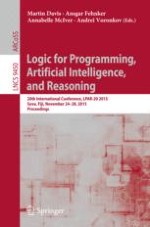2015 | OriginalPaper | Buchkapitel
On the Expressive Power of Communication Primitives in Parameterised Systems
verfasst von : Benjamin Aminof, Sasha Rubin, Florian Zuleger
Erschienen in: Logic for Programming, Artificial Intelligence, and Reasoning
Verlag: Springer Berlin Heidelberg
Aktivieren Sie unsere intelligente Suche, um passende Fachinhalte oder Patente zu finden.
Wählen Sie Textabschnitte aus um mit Künstlicher Intelligenz passenden Patente zu finden. powered by
Markieren Sie Textabschnitte, um KI-gestützt weitere passende Inhalte zu finden. powered by
